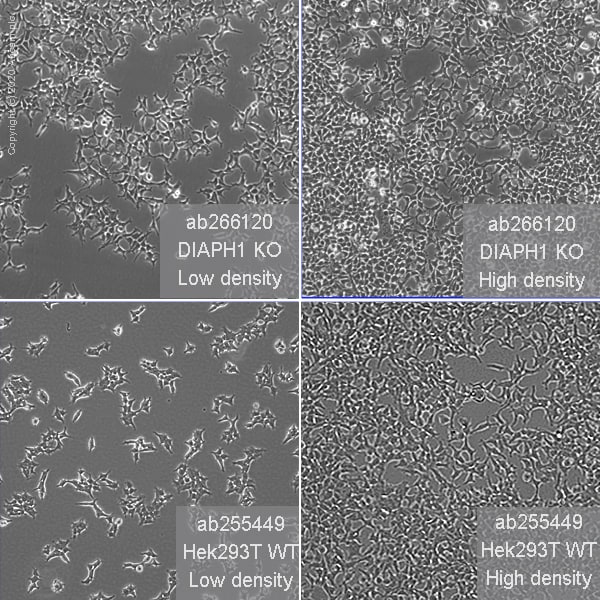Human DIAPH1 knockout HEK-293T cell line (ab266120)
Properties
-
Number of cells
1 x 106 cells/vial, 1 mL -
Viability
~90% -
Adherent /Suspension
Adherent -
Tissue
Kidney -
Cell type
epithelial -
STR Analysis
Amelogenin X D5S818: 8, 9 D13S317: 12, 14 D7S820: 11 D16S539: 9, 13 vWA: 16, 19 TH01: 7, 9.3 TPOX: 11 CSF1PO: 11, 12 -
Mycoplasma free
Yes -
Storage instructions
Shipped on Dry Ice. Store in liquid nitrogen. -
Storage buffer
Constituents: 8.7% Dimethylsulfoxide, 2% Cellulose, methyl ether -
Purity
Immunogen affinity purified -
Research areas
Images
-
Anti-DIAPH1 antibody [EPR7948] (ab129167) at 1/1000 dilution + Wild-type HEK-293T cell lysate at 20 µg
Performed under reducing conditions.
Predicted band size: 141 kDa
Observed band size: 150 kDa why is the actual band size different from the predicted?Lanes 1- 2: Merged signal (red and green). Green - ab129167 observed at 150 kDa. Red - Anti-alpha Tubulin antibody [DM1A] - Loading Control (ab7291) observed at 50 kDa.
ab129167 was shown to react with DIAPH1 in wild-type HEK-293T cells in western blot. Loss of signal was observed when knockout cell line ab266120 (knockout cell lysate ab257411) was used. Wild-type HEK-293T and DIAPH1 knockout HEK-293T cell lysates were subjected to SDS-PAGE. Membrane was blocked for 1 hour at room temperature in 0.1% TBST with 3% non-fat dried milk. ab129167 and Anti-alpha Tubulin antibody [DM1A] - Loading Control (ab7291) overnight at 4°C at a 1 in 1000 dilution and a 1 in 20000 dilution respectively. Blots were developed with Goat anti-Rabbit IgG H&L (IRDye®800CW) preadsorbed (ab216773) and Goat anti-Mouse IgG H&L (IRDye®680RD) preadsorbed (ab216776) secondary antibodies at 1 in 20000 dilution for 1 hour at room temperature before imaging.
-
Homozygous: 1 bp deletion in exon 1
-
Representative images DIAPH1 knockout HEK293T cells, low and high confluency examples (top left and right respectively) and wild-type HEK293T cells, low and high confluency (bottom left and right respectively) showing typical adherent, epithelial-like morphology. Images were captured at 10X magnification using a EVOS M5000 microscope.





